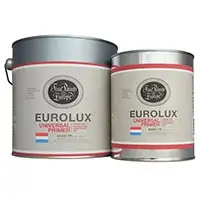Walls, ceilings, and woodwork.
New unpainted surfaces: light sanding and surface cleaning, apply one coat of EUROLUX Universal Primer by brush, roller or spray. Sand with 320 sandpaper before application of finish paint.
Previously painted surfaces: Old finishes in poor condition should be removed or sanded harshly before priming with EUROLUX Universal Primer. Previously painted surfaces must be free of dirt, grease or other contaminates which could interfere with adhesion. After one coat of EUROLUX Universal Primer has been applied, sand with 320 sandpaper before application of the finish paint. EUROLUX Universal Primer should be applied with a synthetic brush, roller or sprayer. Apply smooth, even coats with minimal brushing or rolling, for best results. Do not apply at temperatures below 50 F or above 80 F or when relative humidity exceeds 80%. Clean tools immediately after use with hot water. Drying time: dust-free after approximately 30 minutes; can be recoated after approximately 4 hours. Apply without thinning under normal environmental conditions. If necessary, EUROLUX Universal Primer may be thinned slightly with water ( maximum 3 ounces per Eurogallon/2.5 Liters ). Stir well before use.

